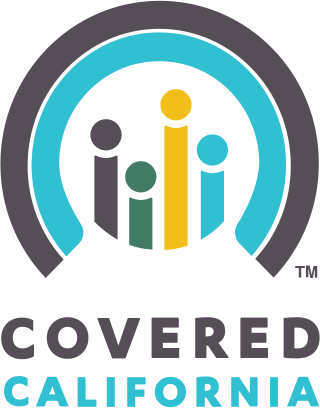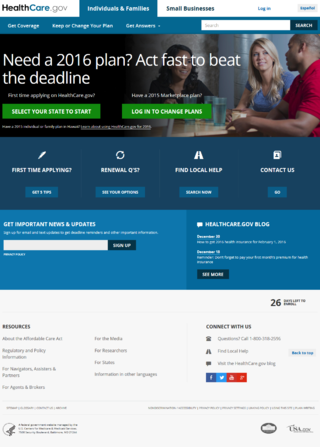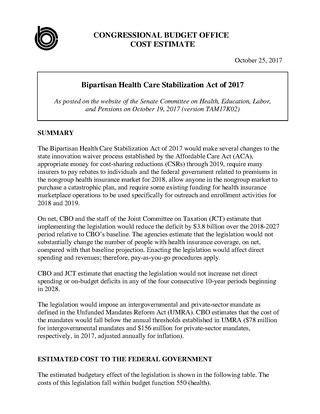Families USA is a nonprofit, nonpartisan consumer health advocacy and policy organization.

The Massachusetts health care reform, commonly referred to as Romneycare, was a healthcare reform law passed in 2006 and signed into law by Governor Mitt Romney with the aim of providing health insurance to nearly all of the residents of the Commonwealth of Massachusetts.
eHealth, Inc. dba eHealthInsurance is a private online marketplace for health insurance, organized in Delaware and based in Santa Clara, California. The company primarily provides plans related to Medicare such as prescription drug plans, Medigap, and Medicare Advantage plans. The company also sells individual plans, competing with health insurance marketplaces. The company sells plans in all 50 U.S. states and the District of Columbia from 170 health insurance carriers. Its large staff of licensed agents assist consumers with little or no computer experience with their online enrollments.
In the United States, health insurance marketplaces, also called health exchanges, are organizations in each state through which people can purchase health insurance. People can purchase health insurance that complies with the Patient Protection and Affordable Care Act at ACA health exchanges, where they can choose from a range of government-regulated and standardized health care plans offered by the insurers participating in the exchange.
Members of the United States population between the ages of 18 and 29 who decide that it is in their financial best interest to forgo health insurance are sometimes referred to as young invincibles by the insurance industry, a term coined to express the idea that the young demographic perceives themselves as immune to sickness and injury. The argument is that these individuals are young and in good health, so they have a low risk of experiencing substantial health issues that would lead to large amounts of spending on health care. Further, this group tends to have a mentality of “it won’t happen to me” with regards to most causes of injury. Together, these beliefs lead to the young invincibles not purchasing insurance.

The Affordable Care Act (ACA), formally known as the Patient Protection and Affordable Care Act (PPACA) and colloquially known as Obamacare, is a landmark U.S. federal statute enacted by the 111th United States Congress and signed into law by President Barack Obama on March 23, 2010. Together with the Health Care and Education Reconciliation Act of 2010 amendment, it represents the U.S. healthcare system's most significant regulatory overhaul and expansion of coverage since the enactment of Medicare and Medicaid in 1965.

Covered California is the health insurance marketplace in the U.S. state of California established under the federal Patient Protection and Affordable Care Act (ACA). The exchange enables eligible individuals and small businesses to purchase private health insurance coverage at federally subsidized rates. It is administered by an independent agency of the government of California.
Washington Healthplanfinder is one of the fourteen health insurance marketplaces in the United States and was created in accordance with the Patient Protection and Affordable Care Act, commonly referred to as Obamacare.
The Affordable Care Act (ACA) is divided into 10 titles and contains provisions that became effective immediately, 90 days after enactment, and six months after enactment, as well as provisions phased in through to 2020. Below are some of the key provisions of the ACA. For simplicity, the amendments in the Health Care and Education Reconciliation Act of 2010 are integrated into this timeline.

HealthCare.gov is a health insurance exchange website operated by the United States federal government under the provisions of the Affordable Care Act or ACA, commonly referred to as “Obamacare”, which currently serves the residents of the U.S. states which have opted not to create their own state exchanges. The exchange facilitates the sale of private health insurance plans to residents of the United States and offers subsidies to those who earn between one and four times the federal poverty line, but not to those earning less than the federal poverty line. The website also assists those persons who are eligible to sign up for Medicaid, and has a separate marketplace for small businesses.

The Exchange Information Disclosure Act is a bill that would require the United States Department of Health and Human Services to submit weekly reports to Congress about how many people are using HealthCare.gov and signing up for health insurance. These reports would be due every Monday until March 31, 2015, and would be available to the public. The bill would "require weekly updates on the number of unique website visitors, new accounts, and new enrollments in a qualified health plan, as well as the level of coverage," separating the data by state. The bill would also require reports on efforts to fix the broken portions of the website.

The Save American Workers Act of 2013 is a bill that would change how the Patient Protection and Affordable Care Act defines full-time worker, by raising the threshold for offering employer-provided insurance from a minimum of 30 to 40 work hours a week. This is in order to remove the incentive some companies may have to reduce their employees' hours in order to avoid the employer healthcare mandate.
Health Insurance Innovations (HII) is a product agnostic insurance technology platform. The firm has headquarters in Tampa, Florida and is listed on NASDAQ. The company uses a cloud-based platform for licensed independent agents to enroll customers in products provided by insurance companies which provide the actual coverage. The firm also provides billing and information services for both the clients and the agents.

The American Health Care Act of 2017 was a bill in the 115th United States Congress. The bill, which was passed by the United States House of Representatives but not by the United States Senate, would have partially repealed the Affordable Care Act (ACA).

The Executive Order Promoting Healthcare Choice and Competition, also known as the Trumpcare Executive Order, or Trumpcare, is an Executive Order signed by Donald Trump on October 12, 2017, which directs federal agencies to modify how the Patient Protection and Affordable Care Act of the Obama Administration is implemented. The order included a directive to federal agencies to end rules forbidding employers from using health reimbursement arrangements (HRAs) to pay individual insurance premiums.

The Bipartisan Health Care Stabilization Act of 2017 was a 2017 proposed compromise reached by senator and HELP Committee chairman Lamar Alexander and senator and HELP Committee ranking member Patty Murray to amend the Affordable Care Act to fund cost-sharing reductions subsidies. The plan will also provide more flexibility for state waivers, allow a new "Copper Plan" or catastrophic coverage for those under 30, allow interstate insurance compacts, and redirect consumer fees to states for outreach. President Trump had stopped paying the cost sharing subsidies and the Congressional Budget Office estimated his action would cost $200 billion, cause insurance sold on the exchange to cost 20% more and cause one million people to lose insurance.
The cost sharing reductions (CSR) subsidy is the smaller of two subsidies paid under the Patient Protection and Affordable Care Act (ACA) as part of the healthcare system in the United States. The subsidies were paid from 2013 to 2017 to insurance companies on behalf of eligible enrollees in the ACA to reduce co-payments and deductibles. They were discontinued by President Donald Trump in October 2017. The nature of the subsidy as discretionary spending versus mandatory was challenged in court by the Republican-controlled House of Representatives in 2014, although payments continued when the ruling in favor of the GOP was appealed by the Obama administration. The non-partisan Congressional Budget Office (CBO) estimated that ending the payments would increase insurance premiums on the ACA exchanges by around 20 percentage points, resulting in increases in the premium tax credit subsidies, thereby adding nearly $200 billion to the budget deficits over the following decade. Critics argued the decision was part of a wider strategy to "sabotage" the ACA.
The Patient Protection and Affordable Care Act, often shortened to the Affordable Care Act (ACA) or nicknamed Obamacare, is a United States federal statute enacted by the 111th United States Congress and signed into law by President Barack Obama on March 23, 2010. Together with the Health Care and Education Reconciliation Act of 2010 amendment, it represents the U.S. healthcare system's most significant regulatory overhaul and expansion of coverage since the passage of Medicare and Medicaid in 1965. Once the law was signed, provisions began taking effect, in a process that continued for years. Some provisions never took effect, while others were deferred for various periods.
Enhanced Direct Enrollment (EDE) is a provision in the United States that allows certain private entities, including insurance carriers and web-brokers, to directly enroll consumers in Qualified Health Plans through the Health Insurance Marketplace without redirecting consumers to Healthcare.gov. Approved EDE partners may access a suite of APIs which allow them to directly submit and update applications on the federal exchange.
GoHealth is a marketplace for Medicare plans including Medicare Advantage, MediGap and Medicare Part D, which are programs administered through private health insurance companies. It also operates an online health insurance marketplace offering individual health insurance and short-term health insurance.






